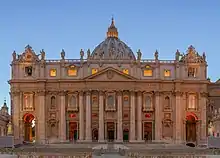
| Part of a series on the |
| Catholic Church |
|---|
 |
| Overview |
|
|
The Armenian Rite (Armenian: Հայկական պատարագ, romanized: Haykakan Patarag) is a liturgical rite used by both the Armenian Apostolic Church and the Armenian Catholic Church.
Liturgy
The liturgy is patterned after the directives of Gregory the Illuminator, first official head and patron saint of the Armenian Church. Churches of the Armenian Rite have a curtain concealing the priest and the altar from the people during parts of the liturgy, an influence from early apostolic times.
The order of the Armenian celebration of the Divine Liturgy of the Eucharist is initially influenced by the Syriac and Cappadocian Christians, then (from the 5th century AD onwards) by Jerusalemites, then by the Byzantine Rite (from circa the 10th century) and later by the Latin liturgical rites. The Armenians are the only liturgical tradition using wine without added water. The Armenian Rite uses the unleavened bread for the Eucharist, part of their historic tradition.[1]
From all the Armenian language anaphoras the only one currently in use is the anaphora of Athanasius of Alexandria. It became the standard anaphora of the Armenian Church before the end of the 10th century and is a translation of the Greek version. In research it is often attributed to Gregory of Nazianzus, or to an older version of the Armenian anaphora of St. Basil or seen as a composite text.
See also
References
- ↑ "Beyond Dialogue: The Quest for Eastern and Oriental Orthodox Unity Today | St Vladimir's Orthodox Theological Seminary". www.svots.edu. Archived from the original on 2013-12-16.
Bibliography
- The Armenian Liturgy, translated into English. San Lazzaro degli Armeni (Italy). 1867. pp. 95. Archived from the original on 2018-11-22. Retrieved 2018-11-22 – via archive.org.
{{cite book}}: CS1 maint: location missing publisher (link)
